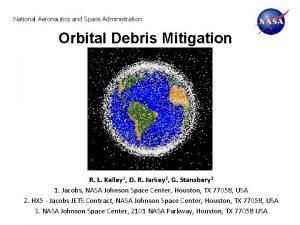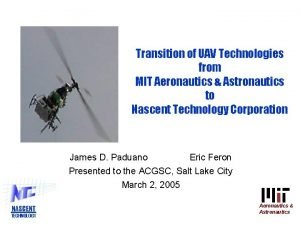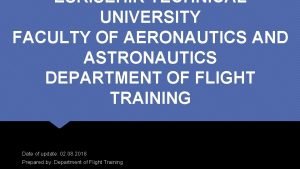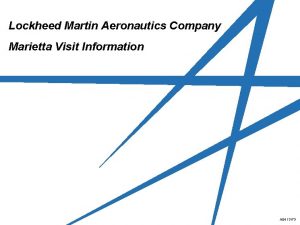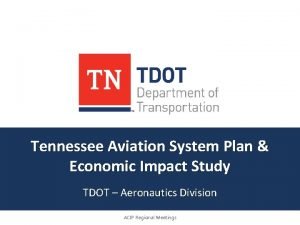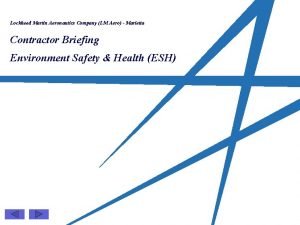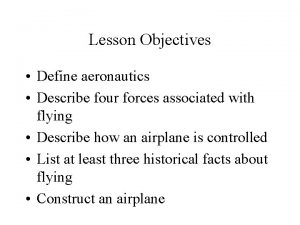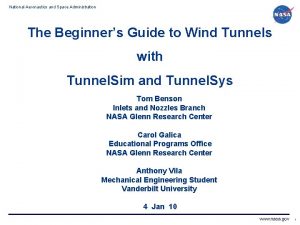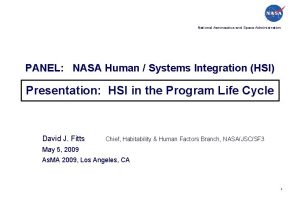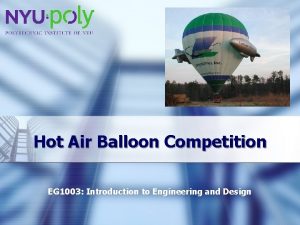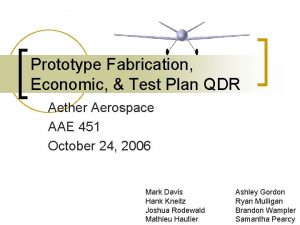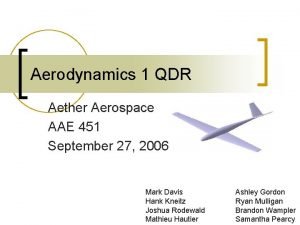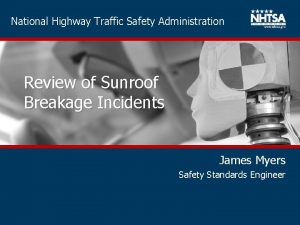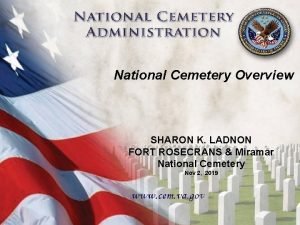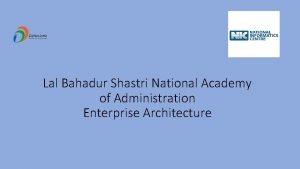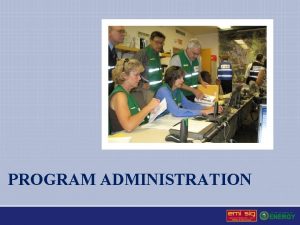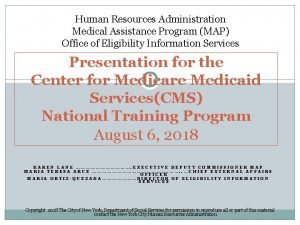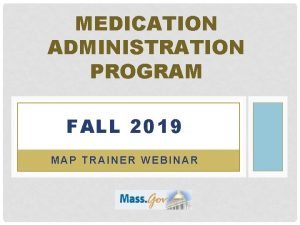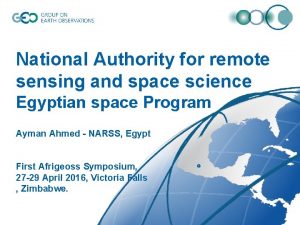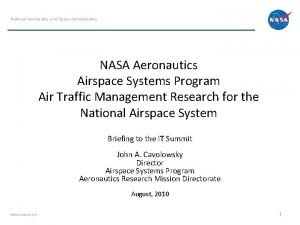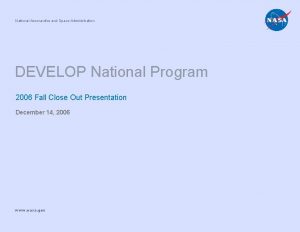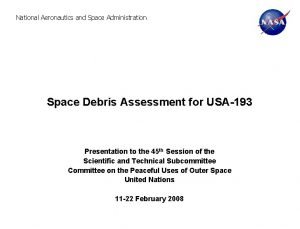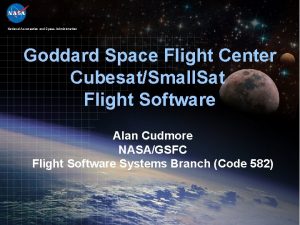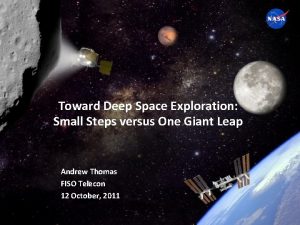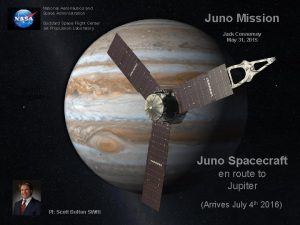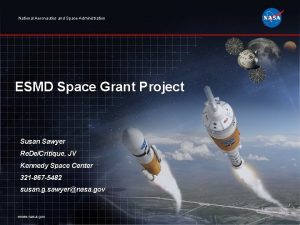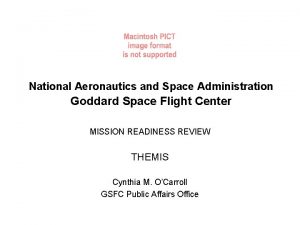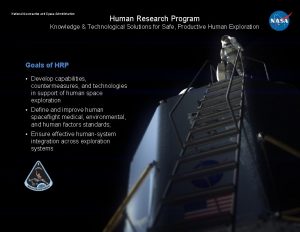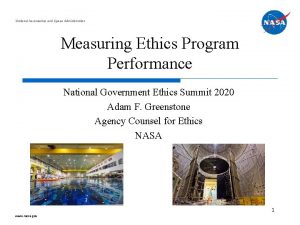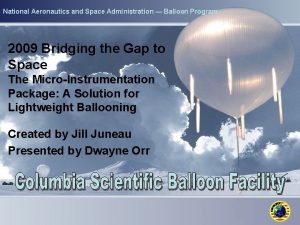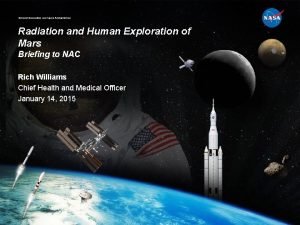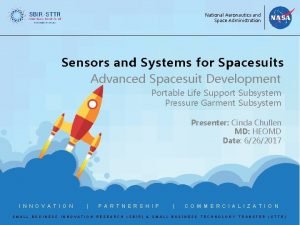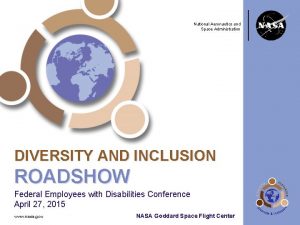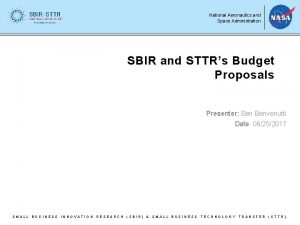National Aeronautics and Space Administration Fundamental Aeronautics Program





























- Slides: 29

National Aeronautics and Space Administration Fundamental Aeronautics Program Subsonic Rotary Wing Project Civil Tiltrotor Fleet in the Next. Gen Airspace Larry A. Young NASA Ames Research Center 2011 Technical Conference March 15 -17, 2011 Cleveland, OH www. nasa. gov

Rotorcraft in the Next. Gen Airspace • Demonstrate analytically that rotorcraft can be successfully integrated into Next. Gen airspace • Identify unique Next. Gen technologies and concepts of operations that might be required to maximize safe, efficient, environmental responsive, and economic employment of rotorcraft in the Next. Gen airspace • Demonstrate with modern, accepted analysis/simulation tools that rotorcraft can be a potential solution to airport/airspace congestion • Provide insights into rotorcraft-specific technology advances that will be required CTR in Next. Gen - 2

Making Sure Rotorcraft Requirements are Factored into Next. Gen Tech & CONOPS • Primary emphasis of Next. Gen implementation is, not unexpectedly, on subsonic fixed-wing jet aircraft • It is vitally important to ensure that rotorcraft requirements are adequately factored into Next. Gen technologies and concepts of operation • Without proper attention to rotorcraft-specific technology and operational questions and issues the full potentiality of future rotorcraft systems might not be realized CTR in Next. Gen - 5

Main Objective of “Modeling High. Speed Civil Tiltrotor Transports in the Next Generation Airspace” Study … to conduct a systems study that addresses the issues associated with deploying a fleet of CTRs by exploring the trades among procedures, CTR capabilities, and overall Next. Gen performance Optimal Synthesis Inc CTR in Next. Gen - 4

Not One, but a Family of Vehicles Being Studied • • • CTR airspace simulations will be based on a fleet of 10 -, 30 -, 90 -, and 120 -PAX vehicles 10 - and 30 -PAX vehicle design heritage based, in part, on BA 609 and V-22 90 - and 120 -PAX vehicles are clean-sheet conceptual designs based on Bell Helicopter technology projections for IOP’s of 2020. Additionally, both VTOL and STOL takeoff and landing profiles have been incorporated in pilot-in-the-loop and airspace simulations Bell PRESTO sizing analysis used for vehicles CTR in Next. Gen - 8

30 -Pax CTR Conceptual Design ICDS CL BL 0. 0 6 deg forward sweep BL 275. 00 457. 00 dia FS 119. 536 FS 417. 000 FS 859. 164 Mast CL WL 152. 36 16 deg WL 35. 00 95. 0 dia 739. 628

30 -Pax CTR Cont. 95. 0 88. 0 34 x 72 Aft Entry Door 2. 0 21. 0 70. 0 Cabin Height 34 x 72 Fwd Entry Door Lavatory This seat only on aft row at aft bhd 21. 50 Floor 72. 0 Floor 91. 50 cockpit 352. 0 cabin length

120 -PAX CTR Conceptual Design BL 0. 0 6 deg fwd sweep BL 590. 40 850. 10 Dia FS 988. 12 FS 421. 09 WL 269. 37 WL 64. 0 156. 0 FS 1763. 73

120 -Pax CTR Cont. 149. 0 34 x 72 Aft Entry Door 34 x 72 Service Door 90 in plus cabin 21. 0 seats 20. 0 aisle 20 x 38 Emergency Exit (2) 34 x 72 Fwd Entry Door 21 width x 32 pitch seats Lavatory 36 in floor Stowage Fwd Galley 74. 0 cockpit First Class Closet 28 width x 38 pitch seats 941. 0 cabin floor Lavatory Aft Pressure Bhd Aft Galley

Summary of Year 1 Effort Convert to BADA Modeling Format 10 -, 30 -, 90 - and 120 -pax CTRs designed by Bell Verified performance with Bell’s data Verified performance with Bell’s 90 -pax CTR design Scaled 10 -, 30 -, 120 -pax BADA models to generate 90 -pax CTR BADA Format Data Integrate BADA data into ACES for CTR NAS Performance analysis CTR in Next. Gen - 10

Summary of Year 1 Effort (Cont’d) Pilot-in-the-Loop Simulation using Miami International Bell’s BA 609 simulator for 10 -pax CTR Bell’s Partial Task Simulator for 30 -pax CTR Developed CTR flight profiles in conversion mode → BADA fuel burn in conversion mode Developed procedures to select VTOL & STOL sites - Interference with existing fixed-wing traffic was to be avoided - Upwind approach, landing, and departures are preferred - Approaches and departures parallel to existing fixedwing traffic patterns are preferred - Buildings/structures in close vicinity to landing zone are to be avoided - Low flight over neighborhoods, highways, taxiways, and runways are to be avoided CTR in Next. Gen - 11

Summary of Year 1 Effort (Cont’d) Major Outcomes from the PITL Identified/reaffirmed required flight control & display augmentation -Generated data to check BADA modeling & Fuel Burn Post Processor -Developed baseline takeoff and approach and landing profiles - Airplane Mode Conversion Mode Level off at Top of Climb Top of Descent (TOC) cruising altitude (TOD) 6 5 Continue climbing in Airplane Mode Complete conversion to Airplane Mode ft/200 knots Begin converting @600 to Airplane mode and 4 climb at 1100 fpm VTOL Takeoff 90˚ Nacelle or STOL Takeoff Warm -up 75˚ at 35 knots 1 3 Cruise 4. 5 Perform Continuous Descent Approach (CDA) Airplane Mode to 250 KCAS 7 Arrival Fix @10, 000 ft Departure Fix @10, 000 ft FAF Prior to intersect GS 10 -passenger 90 knots/75 ˚ Nacelle for 3 ˚ glide 70 knots/80 ˚ Nacelle for 6˚ glide 6 ˚ Nacelle for ˚ glide 50 knots/85 9 30 -passenger Level off @ 1500 ft 90 knots/75 ˚ Nacelle for ˚ glide 3 In Airplane Mode 200 KCAS 70 knots/82 ˚ Nacelle for ˚ glide 6 50 knots/88 ˚ Nacelle for ˚ glide 9 8 9 Convert to 60˚ Nacelle decelerate to 110 knots @400 ft decision Height 2 600 -10 K feet 10 K – 10 K feet 10 K 1500 feet 10 slope slope @200 ft Decision Altitude 11 Landing Spot Helo. Mode Convert to 90˚ Nacelle @ 20 knots or STOL mode Convert to 90˚ Nacelle @ 35 knots Missed 12 CTR in Next. Gen - 12

Summary of Year 2 Effort • • • CTR fleet airspace simulations Initial CTR fleet fuel-burn/carbon emissions estimates Initial CTR terminal area noise predictions using INM NAS Analysis Test Matrix CTR in Next. Gen - 13

CTR Fleet Introduction Airspace Simulations ACES Fix-Based Conventional Routings Mixed-Equipage Conventional Routings Conventional Fixed-Wing Fleet Baseline: Influence of Next. Gen

Assumptions for Next. Gen Performance Analysis ● CTR Fleet Operates in Under-500 Mile Markets ● CTR Capacity Substituted for Conventional Capacity on a Seat-for-Seat Basis ● ACES Delay Metric—OPSNET 45 Airports ● VTOL Vertiport Capacity per Hour: ● 12 Departures ● 12 Arrivals ● 20 Total Operations CTR in Next. Gen - 15

Assumptions for Next. Gen Performance Analysis CTR Substitution on a Seat-for-Seat Basis Replaced Conventional Region Substituted CTR Daily Departures Daily Seats ATL 500 1, 374 114, 817 1, 066 114, 600 LAS 500 622 82, 689 692 83, 040 NEC 500 3, 307 239, 965 2, 654 240, 420 Total 5, 303 437, 471 4, 412 438, 060 CTR in Next. Gen - 16

Vertiport Capacity & Locations With Multiple Vertiports 12 Vertiport Capacity 10 Locations With Multiple Vertiports # 8 Arrivals per Hour 6 4 2 2 BOS 3 IAD 4 PHL 5 LAS 6 ATL BWI DCA EWR JFK LGA PIT 0 0 2 4 6 8 10 12 Departures per Hour CTR in Next. Gen - 17

NAS Analysis Test Matrix & High-Level Results 2025 Capacity Scenario: Test Point Description Baseline Technology (1) Baseline Runways (2) Projected (3) 21. 8 28. 3 10. 2 7. 8 22. 0 28. 5 21. 6 21. 5 8. 1 7. 2 0. 0 0. 1 1. 4 2. 4 3. 4 4. 0 Conventional Fleet, Mixed Equipage Conventional Fleet, Fix-Based Routing 5. 0 CTR 10 Scenario √ 6. 0 VTOL/STOL Operational Comparisons √ 7. 0 8. 0 Sensitivity to CTR Load Factor Assumptions Sensitivity to CTR Taxi Time Assumptions 7. 2 √ CTR 120 Fleet ATL 500, LAS 500, NEC 500 CTR 90 and CTR 120 ATL 500, LAS 500, NEC 500 CTR 30, CTR 90, CTR 120 Mixed ATL 500, LAS 500, NEC 500 CTR 120 Fleet ATL 500, LAS 500, NEC 500 Fix-Based Conventional CTR in Next. Gen - 18

Baseline Delays CTR in Next. Gen - 19

CTR 30, 90 & 120 Mixed Regional Networks CTR in Next. Gen - 20

Delays for a Mixed Fleet of CTR 30, 90, 120 Note: Test Point 3. 4 CTR in Next. Gen - 21

Average Delay Reduction (NAS-wide) from CTR substitution CTR in Next. Gen - 22

CTR Fleet Noise and Emissions • • • Original intent was to use the currently in-development FAA/Volpe AEDT noise and emissions tool for the CTR fleet study This did not prove feasible during the required period of performance for the study • Instead, first-order carbon emission estimates were made on the basis of fuel-burn predictions • And, further, INM (Integrated Noise Model) was used to make CTR terminal noise estimates for EWR airport (as being ideally representative) CTR in Next. Gen - 23

Preliminary Investigation of CTR Fleet Fuel-Burn 140 CTR vs. Conventional Block Fuel per Seat vs. Distance 120 Block Fuel per Seat in Pounds 100 Conv 2025 80 Conv 2009 CTR 30 CTR 120 60 CTR 90 Linear(Conv 2025) Linear(Conv 2009) 40 20 0 0 100 200 300 Great Circle NM 400 500 CTR in Next. Gen - 24

Preliminary Noise Analysis for the CTR Fleet SEL noise contours of 45 in-bound and 45 out-bound flights at EWR using INM (Test Point 3. 4: a mixed CTR 30, CTR 90, and CTR 120 fleet) 25 CTR in Next. Gen - 25

Preliminary Noise Analysis for the CTR Fleet (Cont’d) DNL noise contours of 1491 in-/out-bound flights at EWR using INM Area under 60 d. B contour is 14 square-miles, which is comparable to NASA NVI NRA study of 19 square-miles with the same number of a mix fleet with conventional, CESTOL, and LCTR flights at EWR CTR in Next. Gen - 26

Year 3 Effort (Currently Underway) -- CTR Public Service/Disaster Relief Modeling • • Public service missions are a singular and key aspect of rotorcraft; CTR will be no different During Year 3 effort, specialized simulation tools will be used to assess utility of CTR fleet for disaster relief missions Prototypical scenario to consider is a hurricane relief effort One possibility to consider in analysis is a CRAF-like (Civil Reserve Air Fleet) CTR civilian fleet response to disaster scenario

Concluding Remarks • Recent airspace simulation results support earlier assessments of the potentiality of civil tiltrotor aircraft, in commercial transport roles, to significantly reduce NAS-wide airport delay • Though the introduction of advanced aircraft technologies narrows the anticipated gap between civil tiltrotor aircraft and new generation conventional fixed-wing transport aircraft in terms of fuel burn and noise emissions, considerable work remains

Questions? 2 2 9 9
 National aeronautics and space administration
National aeronautics and space administration National aeronautics and space administration, u.s.a.
National aeronautics and space administration, u.s.a. Mit aeronautics and astronautics
Mit aeronautics and astronautics Pioneer astronautics internship
Pioneer astronautics internship What was the first tool of aeronautics to be developed?
What was the first tool of aeronautics to be developed? Lockheed marietta georgia
Lockheed marietta georgia Tdot aeronautics
Tdot aeronautics Lm aero
Lm aero Define aeronautics
Define aeronautics Beginner's guide to aeronautics
Beginner's guide to aeronautics Hsi
Hsi Aeronautics definition
Aeronautics definition Hot air balloon parts
Hot air balloon parts Aether aeronautics
Aether aeronautics 8:5 aspect ratio
8:5 aspect ratio National academy for public administration
National academy for public administration National academy of statistical administration
National academy of statistical administration National highway safety administration reviews
National highway safety administration reviews National cemetery administration
National cemetery administration Lbsnaa mess menu
Lbsnaa mess menu Program administration
Program administration Hra darb 150 greenwich street
Hra darb 150 greenwich street Tmu map test
Tmu map test National space research and development agency
National space research and development agency National authority for remote sensing and space sciences
National authority for remote sensing and space sciences National unification and the national state
National unification and the national state Cartesian space trajectory planning
Cartesian space trajectory planning Space junk the space age began
Space junk the space age began Camera space to world space
Camera space to world space Cartesian space vs joint space
Cartesian space vs joint space

